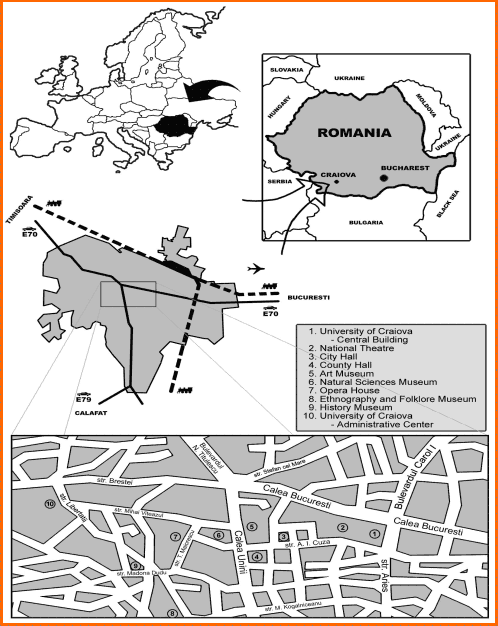 |
|
CRAIOVA
|
|
|
GENERAL INFORMATION
Craiova is
situated in the plain of the river Jiu, connecting Bucharest to
Timisoara (east to west) and the port of Calafat to the province of
Transylvania (south to north). The Carpathians are less than 100 km
from Craiova, while the Danube is very close to the south.
Man has inhabited the area since the Neolitic age, i.e. about 7,500
years before. Much later, a strong Dacian fortress was built,
Pelendava, its name being mentioned in 255 AD on the ancient map
Tabula Pentingeriana. The present name, first appeared in a document
dated 1475, and in 1582 documents mention Craiova as a town. The
rapid development of the place was due not only to its favourable
geographical position but also to the fact that important political
and military institutions of the medieval period moved here, the
town being known as "Marea Banie a Olteniei" ("banie" is a term
designating the capital of a province - approx. "the Great Capital
of Oltenia"). The town grew ever more prosperous and became the
second most important political centre of Valachia; for a short
while, in 1770, the capital of the country temporarily moved here.
In the second half of the 20th century the town grew, new
industrial, commercial and cultural buildings appeared, and it
becomes one of the most important industrial and cultural centre
with an important industrial and cultural centre with rich commerce
and outstanding academic life, a modern city with a population over
320,000 inhabitants. Open to international life, Craiova is
affiliated to Nanterre - France, Kupio - Finland, Valencia - Spain,
Skopje - Macedonia, Vratza - Bulgaria and Skiyan - China.
<
< < top |
|
|
|
GEOGRAPHICAL DETAILS
.

<
< < top |
|
|
|
USEFUL ADDRESSES
Town Council
str. A.I.Cuza 7, tel. +40.51.416236
The Prefekture House of Dolj
Calea Unirii 19, tel +40.51.413893
CFR Agency
Piata Unirii, Complex Unirea, tel. +40.51.411634
Station
B-dul Decebal 5, tel. +40.51.418880
TAROM Agency
Piata Unirii, Complex Unirea, tel. +40.51.411049
Airport
E70. Craiova-București, Km3, tel +40.51.411112
Clinical hospital No 1
B-dul Maresal I. Antonescu 66, tel. +40.51.132662
Police
str. Amaradiei 32, tel +40.51.417575
Useful telephone numbers
Ambulance 961
Police 955
Firemen 981
Information 951
< < < top |
|
|
|
TOURISTIC PLACES
Town Council -
It is a noghothic monument combined with Romanian elements designed
by the architect I. Mincu and was finished by his apprentice C.
Iotzu in 1916. The inside is beautiful and the richness of ornaments
are impressive.
The Prefekture House of Dolj - a magnificent edificent
edifice in the tradition of genuine Romanian architecture, built
between 1910-1913 under the direct supervision of Petre Antonescu.
The inside is a remarkable display of golden ornaments.
The Museum of Ethnography ("Casa Băniei") - The former
residence of the Oltenia province rulers, a medieval building of the
16th century, which houses Romanian folk art exhibits.
The Art Museum ("Jean Mihail" Palace) - Designed by the
French architect Paul Gauttereau, combining elements specific to the
Renaissance and late Baroque periods, richly ornamented with
Venetian mirrors and Murano candelabra, while beautiful pieces of
wall tapistry in Lyon silk and Carara marble stairs can be admired
throughout the place. This is also the place of a fine collection of
fine arts and a "Constantin Brancusi" room.
The Museum of Archacology and History - hauses valuable
archacological and numicmatic collections.
The Metropolitan Cathedral (orthodox religion) - built at the
beginning of the 16th century with St. Dimitrie as patron is located
in the old precincts of Craiova. The paintigs on the walls in
Neo-Byzantine style, date from 1907-1933 and are the work of French
painters.
"Madona Dudu" Church- whose name originates in the legend of
the icon of Virgin Mary, which was found in the wall on that very
site. Built between 1928-1938, the chrch was designed by the
architects Traianescu and Becu is a remarkable Neo-Byzantine style.
< < < top |
|
|
|
FESTIVALS AND CELEBRATIONS OF THE CITY
|
January |
-
The "Caragiale" Festival (every two years
at the National Theatre)
|
|
February |
-
The "Marin Sorescu" Festival (The National
Theatre)
|
|
March |
-
The International Chamber Music Festival
(The Oltenia Philarmonic Concert Hall)
-
The Operetta Festival (The Opera and
Operetta Theatre)
|
|
April |
-
The "Shakespeare" Festival (every two years
at the National Theatre)
|
|
May |
-
The "Amza Pellea" Festival (The National
Theatre)
-
The "Maria Tanase" Contest of Romanian Folk
Music Singers (every two years at the National Theatre)
-
The "Ion Vasilescu" Light Music Festival
(The Opera and Operetta Theatre, every two years)
-
The Folk Artisans' Fair (outside the
National Theatre)
|
|
June |
-
The Parade of Oltenia's Folk Dance (The
Open-air Theatre, Romanescu Park, during the Whitsuntide)
|
|
September |
-
The International Festival of Choral Music
(The Oltenia Philarmonic Concert Hall)
-
The Classical Guitar Music Festival (The
Oltenia Philarmonic Concert Hall)
|
|
October |
-
on Oct. 26: The City Festival and the
Holiday
-
Festival of operetta "Elena Teodorini" (The
Opera and Operetta Theatre)
|
|
November |
-
The International Festival: "Craiova
Muzicala" (The Oltenia Philarmonic Concert Hall)
|
|
December |
-
Festival of Christmas Carrols and Sacred
Music (The Oltenia Philarmonic Concert Hall and in the streets
of Craiova)
|
< < < top | |